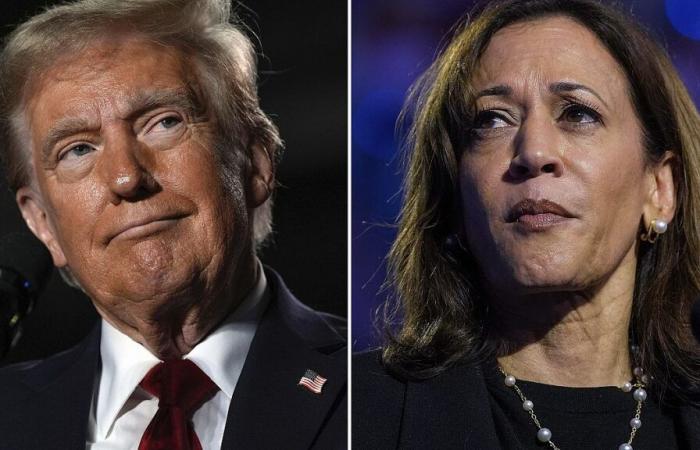A constitutional amendment more than two centuries old determines the choice of winner in the event of a draw.
ADVERTISEMENT
Kamala Harris and Donald Trump are fighting to the last vote to gain the upper hand in Tuesday’s election. However, there is a slight possibility that the American vote will end in a draw.
This concerns the mechanisms of the American electoral college, the “winner-takes-all” system (the winner takes all the votes received by the state, where he or she wins the popular vote, in the national electoral college) which determines which presidential candidate will win the White House.
The electoral college includes 538 votesdistributed in varying proportions among the fifty states and the District of Columbia. A tie between two presidential candidates is therefore theoretically possible.
Harris and Trump could each obtain 269 electoral votes, which would result in a total tie scenario, with both candidates unable to obtain the majority of electoral votes required to become president.
Similar impasses have occurred twice in U.S. history, in 1800 and 1824.
What happened when there was a tie in the past?
In the election of 1800, Thomas Jefferson’s Democratic-Republicans defeated incumbent Federalist President John Adams.
At the time, presidential candidates had a “running mate” from another state, as is the case for vice-presidential candidates today. The electors had to vote twice each: the candidate with the greatest number of votes became president, while the candidate with the second highest number of votes became vice-president.
However, the Democratic-Republicans did not coordinate well, so their presidential candidate (Jefferson) received the same number of votes as their vice-presidential candidate (Aaron Burr).
The election was therefore decided by the House of Representatives according to the rule “one state, one vote”, after a long impasse which almost led to a military confrontation, as pointed out by Sanford Levinson, professor at the faculty of law from the University of Texas.
It is for this reason that the 12th Amendment was introduced, which still governs the election of the President of the United States. It specifies that the electors “will designate in their ballot papers the person for whom they voted as president, and in separate ballot papers the person for whom they voted as vice-president”, in order to avoid any possible equality between candidates from the same party.
However, it remains possible that no candidate obtains a majority of the total number of elected electors – currently, this crucial threshold is 270.
This happened in 1824, when Andrew Jackson received 99 votes, John Quincy Adams 84, William Crawford 41, and Henry Clay 37. All of these candidates belonged to the same Democratic-Republican political party, which was divided into factions regional.
The 12th Amendment stipulates that in such a case, the House of Representatives immediately chooses the president by ballot from among the first three choices of the electors. Voting is by state, with each state having one vote and a simple majority required.
This means that Wyoming, the smallest state in the United States with fewer than 600,000 residents, would have the same weight in choosing the new president as California, which has nearly 40 million residents (even though Wyoming does not only appoints three electors and California 54).
In addition, the choice of the new president would depend on the composition of the House of Representatives, which must be voted on in parallel with the presidential elections.
What is the probability of a tie?
Although a tie is unlikely, it remains a possibility to consider, as shown by the different scenarios presented by the site 270toWin.
One such scenario has Trump winning Pennsylvania and Georgia, while Harris secures victories in Wisconsin, Michigan, Arizona, Nevada and an electoral vote in Nebraska, which is, along with Maine, the only state to divide its electoral allocation.
Another, even more unlikely scenario is that Mr. Harris wins all the states won by Mr. Biden, plus North Carolina, which current polls show could go to Republican hands. If Trump then picks up Michigan, Pennsylvania and Wisconsin, and also wins Nevada for the first time, the result would be a 269-269 tie.
This would trigger a “conditional election,” with the House of Representatives tasked with choosing the president of the United States for the first time in two centuries, which would require a simple majority of 26 states to elect the new commander in chief.
With the country sharply divided, newly sworn-in U.S. congressmen would be under immense pressure and, in some cases, would have to choose between supporting their party’s candidate or the one who received the most popular votes in their own state (the State delegations are not required to honor the winner of their state’s vote).
According to an analysis by the Congressional Research Service, this situation would likely occur on January 6, just after Congress determines that no candidate has a majority.
Even more surprising, the equality scenario could lead to cohabitation between a Republican president and a Democratic vice-president or vice versa.
Indeed, according to the 12th amendment, in the event of a lack of majority, the American vice-president is chosen by the Senate from among the two candidates having obtained the greatest number of electoral votes, each senator having the right to one vote (the Senate American has 100 members, each state electing two).
Finally, the Senate can choose a vice president even if the House is deadlocked in electing the president. Thus, if a president is not chosen before January 20, inauguration day, the newly elected vice-president will act as interim president. This is a scenario that no one in the United States can envisage today.






